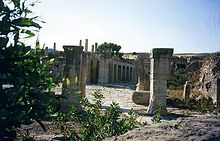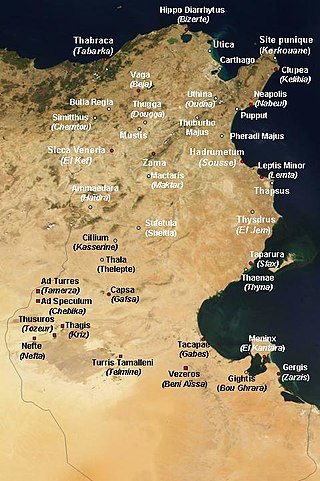
Musti or Mustis was an ancient city and bishopric in the Roman province of Proconsular Africa, now in northern Tunisia. Its ruins, called Mest Henshir, are about eight miles from Dougga, near Sidi-Abd-Er-Rebbou. It is also a Catholic titular see.

Musti or Mustis was an ancient city and bishopric in the Roman province of Proconsular Africa, now in northern Tunisia. Its ruins, called Mest Henshir, are about eight miles from Dougga, near Sidi-Abd-Er-Rebbou. It is also a Catholic titular see.
Musti was an important town in the Roman era, located along the Roman road that ran between Carthage and Tebessa, eight miles from Dougga, and near Sidi-Abd-Er-Rebbou. [1] The limits of the town were set in 238 by two triumphal arches, erected on this road which traversed Musti from east to west. Towards the end of 2nd century BC the Roman general Gaius Marius settled his veterans here and at a later time it was elevated to the rank of a municipium by Julius Caesar or by Marcus Aurelius. The ancient Roman town lost its appearance when the Byzantines transformed it into a stronghold during their struggles against the Vandals.

The town has only been partially excavated, leaving a large area still to be researched, but nevertheless boasts remains of the forum, the marketplace, built in white calcareous stone [2] several temples, the cisterns, [2] a Byzantine citadel, and a number of Roman houses. There is also a church with a baptistry. [2]
Three temples have been identified at Musti though others were known, One of the temples was converted to a bascillica in the 4th century [2]
Musti is mentioned by Ptolemy, [3] the Itinerarium Antonini , the Peutinger Table, and the Ravenna geographer Vibius Sequester, who narrates the killing at this place of an enormous serpent by Regulus. The inscriptions call the inhabitants Musticenses or Mustitani; the latter name is also used by Augustine. [4]
The Byzantines turned much of the Forum into a fortress during their battles with the Vandals. [5]
The triumphal arch located at the entrance of the site is still of unknown attribution. The eastern arch, which was in a very ruined state, was restored in 1967 by the National Institute of Art and Archaeology and the Historical Monuments Service. The nearby mausoleum of the Julii was also restored at this time. The entire restoration took 17 months to complete.
The entrance of the site opens onto a large paved yard which leads to an attractive gateway. This gate had a covered walkway on the left and on the right. To the sides are the shops of the moneychangers and some bas-reliefs of well-wishing genies.
Near the gate are the remains of three temples (to Ceres, Pluto and Apollo). Further on are ruins of a small 4th century Christian church, a basilica with three naves and a raised sacred area (the baptistery). It is adjoined by a large Byzantine fortification.
In 2018, a joint Polish-Tunisian project was commenced by the Polish Centre of Mediterranean Archaeology and the Institute of Archaeology (both University of Warsaw) and the Tunisian Institut National du Patrimoine. [6] A geophysical prospection using the magnetic and electrical resistivity methods was conducted to locate archaeological remains, both in the area where urban architecture was visible on the surface and in the town's vicinity. [7] In 2019, a team of epigraphists documented over 130 Latin inscriptions from the Roman period; their total number at the site is estimated at more than 500. Sondages were also made, and the stratigraphy of the layers was established, reaching back to the pre-Roman period (6th–3rd century BC) when Mustis was inhabited by Numidian tribes. [8]

It was a bishopric, suffragan of the Metropolitan Archbishop of Carthage, both in the Roman province of Africa Proconsularis.
There also was another city and bishopric called Musti in Numidia (modern Algeria), which Sophrone Pétridès confuses with the Musti in the Roman province of Proconsular Africa, even to the extent of presenting the supposed single see as represented at the 411 Council at Carthage by four bishops, two Donatist (Felicianus [9] and Cresconius) and two Catholic (Victorianus and Leontius). [4] J. Mesnage distinguishes between the two sees, assigning Felicianus and Victorianus to the Musti of Proconsular Africa, a suffragan of Carthage, and Cresconius and Leontius to what he calls Musti Numidiae. [10] The Catholic Church's list of titular sees also distinguishes between the two, calling one see simply Musti and the other Musti in Numidia. [11] Mesnage also distinguishes between the sees of two other bishops of whom Pétridès speaks as bishops of a single Musti: an Antonianus of the Numidian Musti was one of the bishops whom the Vandal king Huneric exiled in 482, and the Januarius who in 646 signed the letter of the bishops of Proconsular Africa to Paul, Patriarch of Constantinople, against the monothelites, was obviously of that province. [9]
In 1912, the diocese was nominally restored as a Latin titular see, of the lowest (episcopal) rank with a single (archiepiscopal) exception. It has had the following incumbents:

Thapsus, also known as Tampsus and as Thapsus Minor to distinguish it from Thapsus in Sicily, was a Carthaginian and Roman port near present-day Bekalta, Tunisia.
Usilla or Usula was a town in the Roman province of Byzacena, now Inchilla in Tunisia.

Haïdra is a municipality in western Tunisia, containing the ruins of Ammaedara, one of the oldest Roman cities in Africa. It was a diocese and is now a Roman Catholic titular see.
Scillium is an ancient city in the Roman province of Africa Proconsularis, Scillium must not be confounded with Silli, or Sililli, in Numidia, the situation of which is unknown nor, as Albert Battandier does, identified with Kasrin, which is Cillium, a see of Byzantium. Its episcopal see was a suffragan of the see of Carthage, capital of the province.
Obba was an Ancient town in Roman North Africa. It is now a Latin Catholic titular see.
Ruspe or Ruspae was a town in the Roman province of Byzacena, in Africa propria. It served as the episcopal see of Saint Fulgentius of Ruspe. It is now a Roman Catholic titular bishopric.

Téboursouk is a town and commune in the Béja Governorate, Tunisia. It is located at 36° 27′ 26″N, 009° 14′ 54″E.
Musti in Numidia, also called Musti Numidiae, was an ancient city and bishop jurisdiction (bishopric), and is presently a Catholic titular see,(bishop's government see of a former government under a church's responsibility, also known as a dead diocese.) in modern Algeria.
Henchir-Tebel is a town and archaeological site in Al Qayrawān, Tunisia, near Kairouan

Sutunura was a Roman era civitas in the Roman province of Africa and is tentatively identified with ruins near Aïn-El-Askerm, Rdir-Es-Soltan in modern Tunisia.(36° 34' 29" North, 9°59'29"East) 50 km from Carthage. The location being confirmed with inscription remains in situ and is nearby to Koudiat es Somra, Jebel Barrou and Ghedir Soltane.
Buleliana was a civitas (town) and bishopric in Roman North Africa and remains a Latin Catholic titular see.
Cellae in Proconsulari was an ancient city and bishopric in Roman Africa, which remains a Latin titular see.

Medeli was an ancient Roman–Berber civitas of the Roman Province of Africa Proconsularis in Tunisia. It has been tentatively identified with Henchir-Mencoub and lasted through the Roman, Vandal and Byzantine empires.
Theudalis, also known as Teudali, was a Roman era civitas (town) of the Roman province of Africa Proconsularis. The ancient city is tentatively identifiable with ruins at Henchir-Aouam in Tunisia.
Henchir-El-Meden is a locality and archaeological site in Tunisia.
Sebkha-El-Coursia is a salt pan, locality and archaeological site in Tunisia. It was an ancient Roman Catholic diocese.
Henchir-Khachoum is a locality and series of archaeological sites in Sidi Bouzid Governorate modern Tunisia. The ruins are strewn along a tributary of the Oued El Hatech river east of Sbeitla. During the Roman Empire there was a Roman town of the Roman province of Africa Proconsularis, called Muzuca, one of two North African towns to bare that name.
Cilibia was an Ancient city and bishopric in Roman North Africa, which remains a Latin Catholic titular see.
Sicilibba was an ancient Roman town of the Roman province of proconsular Africa. The ancient town is tentatively identifiable with the ruins at Alaouine in today's Tunisia.
The Diocese of Vittoriana is a suppressed and titular see of the Roman Catholic Church.